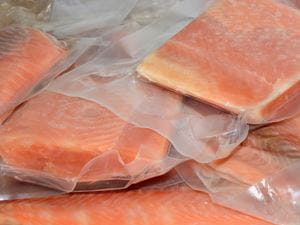Imagine visiting a restaurant and seeing a chef cooking without shoes or taking advantage of the 10-second rule. Wouldn’t you walk out? Yes, restaurants should be held to a higher standard than you cooking at home, with more people coming and going, increasing the potential exposure to food-related sickness. Still, getting food poisoning from your cooking is almost a cruel joke. Food safety aside, some restaurant rules can make kitchens more efficient and cleaner, which is appealing. There are some ways you can benefit from being more buttoned up in your kitchen. Here are some everyday kitchen habits that are unsanitary.
Stuffing food in the fridge.

Most people put food in the fridge wherever there’s space without thinking about it. However, restaurants must follow strict guidelines about where to put items in the refrigerator to avoid cross-contamination. For example, raw food could contain pathogens that make people sick, so they mustn’t come in contact with ready-to-eat foods. Try storing your raw foods below the ready-to-eat options so they don’t touch each other in case the packages leak. Using the proper containers and lids and cleaning your refrigerator regularly is also essential to prevent moisture or dirt buildup, which could lead to food contamination.
Putting newer items in the front of the refridgerator.

What would be at the front of your refrigerator if you were to look inside right now? Putting your go-to items in front might make organizational sense, but restaurants use a method called first in, first out. You want to use the oldest product first based on the stated shelf life. This method ensures that everything gets used to prevent expired food from hanging out in the fridge, completely forgotten in the back.
Dipping your spoon into the food for a taste.

Part of the fun of cooking at home is tasting as you go, and it can be essential in ensuring you have the right spice balance. Taste testing in restaurant kitchens is allowed, but there are strict rules for how to do it. Because people can carry pathogens, taste testing is an easy way to introduce bacteria into food. You can taste it, but it should be done so the taster doesn’t contaminate the meal. The safe way to taste test food is to use a disposable plate or utensil to take a sample from the dish and then step away as you taste it.
Thawing fish or meat on the counter.

Cooking fish or meat for dinner requires some forward thinking. You’ve probably never thought twice about pulling meat out of the freezer and leaving it on the counter to thaw while running errands or at work. However, that would never happen at a restaurant. This method can lead to temperature abuse of the food. With raw fish and meats, it can also lead to spoilage of the product and the growth of bacterial pathogens. Restaurant workers do a controlled thaw, maintaining adequate temperatures throughout the process.
Drying dishes with a dish towel.

Anyone who’s ever worked in a restaurant kitchen knows when the food safety inspector comes, you have to hide the dish towels immediately and remove them from the countertops. That’s because dish towels can be a breeding ground for bacteria. Drying utensils with a dish towel can potentially recontaminate them if the towel is contaminated. Instead, try air-drying your knives, forks, and spoons.
Letting your pet hang out in the kitchen.

This may be obvious, but animals aren’t allowed in restaurant kitchens for a reason. They could contaminate areas with their drool, hair, and other secretions. Both dogs and cats carry germs that cause foodborne illness. If you allow your pet in the kitchen, at least wash your hands between prepping your meal and giving them some love.
Putting these unsanitary habits to bed makes your kitchen a clean place to eat and cook, even if you occasionally abide by the 10-second rule. In the meantime, try your best to maintain sanitary kitchen habits while cooking at home and you won't have to worry about food poisoning.
